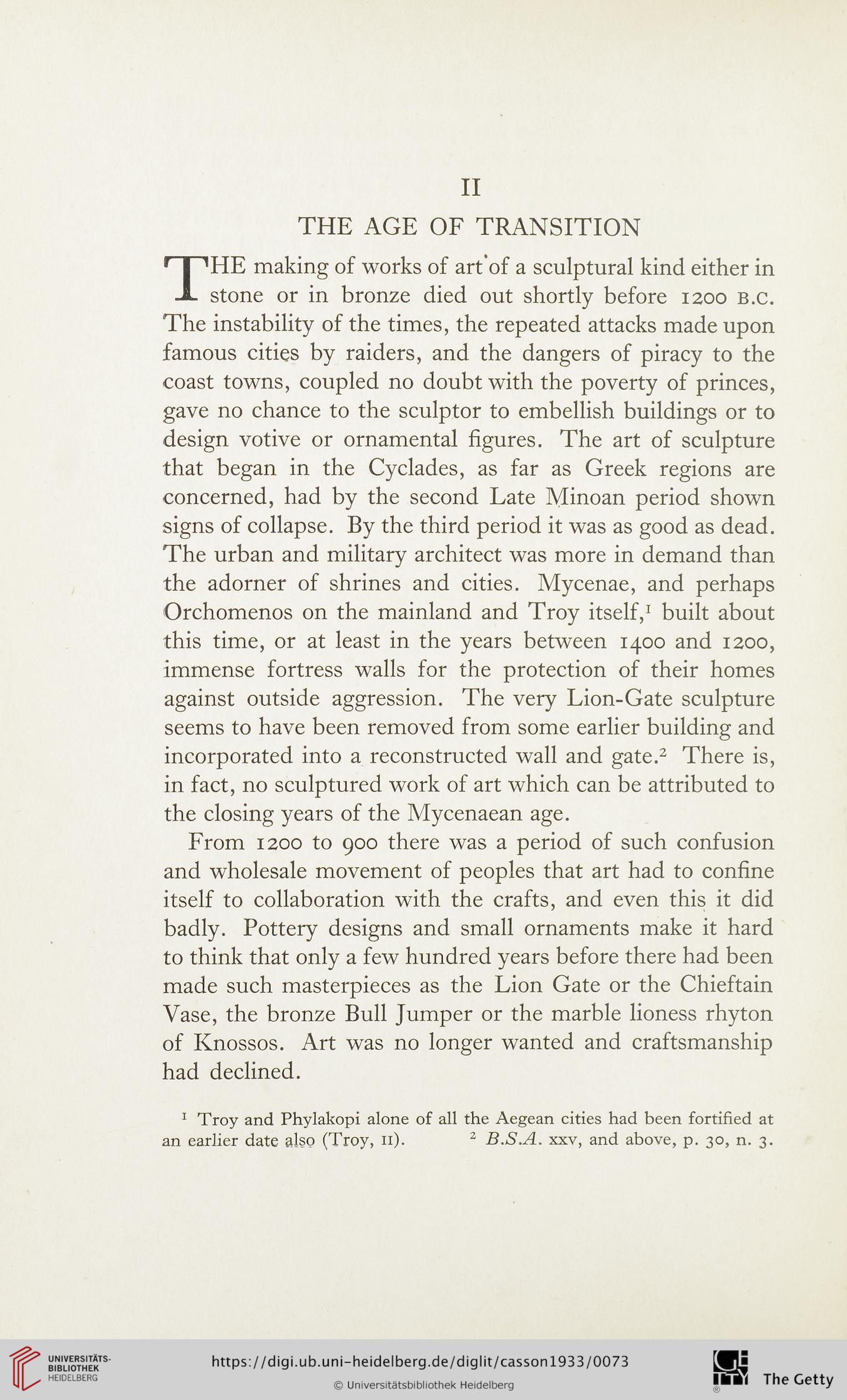II
THE AGE OF TRANSITION
THE making of works of art'of a sculptural kind either in
stone or in bronze died out shortly before 1200 B.c.
The instability of the times, the repeated attacks made upon
famous cities by raiders, and the dangers of piracy to the
coast towns, coupled no doubt with the poverty of princes,
gave no chance to the sculptor to embellish buildings or to
design votive or ornamental figures. The art of sculpture
that began in the Cyclades, as far as Greek regions are
concerned, had by the second Late Minoan period shown
signs of collapse. By the third period it was as good as dead.
The urban and military architect was more in demand than
the adorner of shrines and cities. Mycenae, and perhaps
Orchomenos on the mainland and Troy itself,1 built about
this time, or at least in the years between 1400 and 1200,
immense fortress walls for the protection of their homes
against outside aggression. The very Lion-Gate sculpture
seems to have been removed from some earlier building and
incorporated into a reconstructed wall and gate.2 There is,
in fact, no sculptured work of art which can be attributed to
the closing years of the Mycenaean age.
From 1200 to 900 there was a period of such confusion
and wholesale movement of peoples that art had to confine
itself to collaboration with the crafts, and even this it did
badly. Pottery designs and small ornaments make it hard
to think that only a few hundred years before there had been
made such masterpieces as the Lion Gate or the Chieftain
Vase, the bronze Bull Jumper or the marble lioness rhyton
of Knossos. Art was no longer wanted and craftsmanship
had declined.
1 Troy and Phylakopi alone of all the Aegean cities had been fortified at
an earlier date also (Troy, 11). 2 B.S.A. xxv, and above, p. 30, n. 3.
THE AGE OF TRANSITION
THE making of works of art'of a sculptural kind either in
stone or in bronze died out shortly before 1200 B.c.
The instability of the times, the repeated attacks made upon
famous cities by raiders, and the dangers of piracy to the
coast towns, coupled no doubt with the poverty of princes,
gave no chance to the sculptor to embellish buildings or to
design votive or ornamental figures. The art of sculpture
that began in the Cyclades, as far as Greek regions are
concerned, had by the second Late Minoan period shown
signs of collapse. By the third period it was as good as dead.
The urban and military architect was more in demand than
the adorner of shrines and cities. Mycenae, and perhaps
Orchomenos on the mainland and Troy itself,1 built about
this time, or at least in the years between 1400 and 1200,
immense fortress walls for the protection of their homes
against outside aggression. The very Lion-Gate sculpture
seems to have been removed from some earlier building and
incorporated into a reconstructed wall and gate.2 There is,
in fact, no sculptured work of art which can be attributed to
the closing years of the Mycenaean age.
From 1200 to 900 there was a period of such confusion
and wholesale movement of peoples that art had to confine
itself to collaboration with the crafts, and even this it did
badly. Pottery designs and small ornaments make it hard
to think that only a few hundred years before there had been
made such masterpieces as the Lion Gate or the Chieftain
Vase, the bronze Bull Jumper or the marble lioness rhyton
of Knossos. Art was no longer wanted and craftsmanship
had declined.
1 Troy and Phylakopi alone of all the Aegean cities had been fortified at
an earlier date also (Troy, 11). 2 B.S.A. xxv, and above, p. 30, n. 3.




